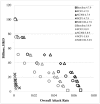Economic Evaluation of Individual School Closure Strategies: The Hong Kong 2009 H1N1 Pandemic
- PMID: 26820982
- PMCID: PMC4731466
- DOI: 10.1371/journal.pone.0147052
Economic Evaluation of Individual School Closure Strategies: The Hong Kong 2009 H1N1 Pandemic
Abstract
Background: School closures as a means of containing the spread of disease have received considerable attention from the public health community. Although they have been implemented during previous pandemics, the epidemiological and economic effects of the closure of individual schools remain unclear.
Methodology: This study used data from the 2009 H1N1 pandemic in Hong Kong to develop a simulation model of an influenza pandemic with a localised population structure to provide scientific justifications for and economic evaluations of individual-level school closure strategies.
Findings: The estimated cost of the study's baseline scenario was USD330 million. We found that the individual school closure strategies that involved all types of schools and those that used a lower threshold to trigger school closures had the best performance. The best scenario resulted in an 80% decrease in the number of cases (i.e., prevention of about 830,000 cases), and the cost per case prevented by this intervention was USD1,145; thus, the total cost was USD1.28 billion.
Conclusion: This study predicts the effects of individual school closure strategies on the 2009 H1N1 pandemic in Hong Kong. Further research could determine optimal strategies that combine various system-wide and district-wide school closures with individual school triggers across types of schools. The effects of different closure triggers at different phases of a pandemic should also be examined.
Conflict of interest statement
Figures









Similar articles
-
School closure policies at municipality level for mitigating influenza spread: a model-based evaluation.BMC Infect Dis. 2016 Oct 18;16(1):576. doi: 10.1186/s12879-016-1918-z. BMC Infect Dis. 2016. PMID: 27756233 Free PMC article.
-
[Effects of school closure during influenza A/H1N1 pandemic in 2009 in Japan].Nihon Eiseigaku Zasshi. 2013;68(2):103-17. doi: 10.1265/jjh.68.103. Nihon Eiseigaku Zasshi. 2013. PMID: 23718972 Review. Japanese.
-
Simulating school closure policies for cost effective pandemic decision making.BMC Public Health. 2012 Jun 18;12:449. doi: 10.1186/1471-2458-12-449. BMC Public Health. 2012. PMID: 22713694 Free PMC article.
-
The 2009 H1N1 influenza pandemic and Minnesota's K-12 schools: public health lessons learned.Minn Med. 2010 Sep;93(9):36-40. Minn Med. 2010. PMID: 20957924
-
The epidemiological and public health research response to 2009 pandemic influenza A(H1N1): experiences from Hong Kong.Influenza Other Respir Viruses. 2013 May;7(3):367-82. doi: 10.1111/j.1750-2659.2012.00420.x. Epub 2012 Aug 9. Influenza Other Respir Viruses. 2013. PMID: 22883352 Free PMC article. Review.
Cited by
-
Costs and benefits of interventions aimed at major infectious disease threats: lessons from the literature.Eur J Health Econ. 2020 Dec;21(9):1329-1350. doi: 10.1007/s10198-020-01218-4. Epub 2020 Aug 13. Eur J Health Econ. 2020. PMID: 32789780 Free PMC article. Review.
-
An introduction to economic studies, health emergencies, and COVID-19.J Evid Based Med. 2020 May;13(2):161-167. doi: 10.1111/jebm.12395. J Evid Based Med. 2020. PMID: 32470229 Free PMC article.
-
Brief Research Report on Adolescent Mental Well-Being and School Closures During the COVID-19 Pandemic in Indonesia.Front Psychiatry. 2020 Nov 17;11:598756. doi: 10.3389/fpsyt.2020.598756. eCollection 2020. Front Psychiatry. 2020. PMID: 33312144 Free PMC article.
-
School closure and management practices during coronavirus outbreaks including COVID-19: a rapid systematic review.Lancet Child Adolesc Health. 2020 May;4(5):397-404. doi: 10.1016/S2352-4642(20)30095-X. Epub 2020 Apr 6. Lancet Child Adolesc Health. 2020. PMID: 32272089 Free PMC article.
-
A Systematic Review of the Costs Relating to Non-pharmaceutical Interventions Against Infectious Disease Outbreaks.Appl Health Econ Health Policy. 2021 Sep;19(5):673-697. doi: 10.1007/s40258-021-00659-z. Epub 2021 Jun 11. Appl Health Econ Health Policy. 2021. PMID: 34114184 Free PMC article.
References
-
- The Canadian pandemic influenza plan for the health sector. Public Health Agency of Canada. 2011 [cited 2015 May 19]. Available from: http://www.phac-aspc.gc.ca/cpip-pclcpi/.
-
- Hong Kong’s preparedness for influenza pandemic–prevention and protection. HK Government. 2007 [cited 2015 May 19]. Available from: http://www.info.gov.hk/healthzone/chp/Hong_Kong_Preparedness_for_Influen....
-
- Principles governing the closure of schools and other educational facilities in Western Australia during a human influenza pandemic. Government of Western Australia. 2015 [cited 2015 May 19]. Available from: http://www.public.health.wa.gov.au/cproot/2253/2/school%20closures.pdf
Publication types
MeSH terms
LinkOut - more resources
Full Text Sources
Other Literature Sources
Medical

